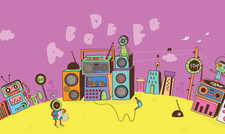Creating artistic images with ASCII art
The Art of Letters

Creating images from letters and numbers is a complex matter, unless you have the right tools at hand.
ASCII artists are often genuine tinkerers: With meticulous attention, they create images, and even movies, solely from letters and digits. The combination of simple means and complexity of images is always fascinating. This extravagant art form goes back to the first half of the 20th century and has been known since the 1960s as ASCII art.
The images only use character sets without non-standard characters. These Latin characters are based on the English alphabet and later on the American Standard Code for Information Interchange (ASCII). They contain uppercase and lowercase letters, basic delimiters, and control characters that come from the world of the telegraph. These characters can be found on almost any computer, allowing users to display the image in an identical manner wherever they are.
Artistic opportunities arise in particular by leveraging the amount of black in the various characters. The artist creates transitions between light and dark, and individual shapes, such as arches and curves, through different shades. The human brain's ability to abstract and recognize images using patterns assures the desired effect.
[...]
Buy this article as PDF
(incl. VAT)
Buy Linux Magazine
Subscribe to our Linux Newsletters
Find Linux and Open Source Jobs
Subscribe to our ADMIN Newsletters
Support Our Work
Linux Magazine content is made possible with support from readers like you. Please consider contributing when you’ve found an article to be beneficial.

News
-
Parrot OS Switches to KDE Plasma Desktop
Yet another distro is making the move to the KDE Plasma desktop.
-
TUXEDO Announces Gemini 17
TUXEDO Computers has released the fourth generation of its Gemini laptop with plenty of updates.
-
Two New Distros Adopt Enlightenment
MX Moksha and AV Linux 25 join ranks with Bodhi Linux and embrace the Enlightenment desktop.
-
Solus Linux 4.8 Removes Python 2
Solus Linux 4.8 has been released with the latest Linux kernel, updated desktops, and a key removal.
-
Zorin OS 18 Hits over a Million Downloads
If you doubt Linux isn't gaining popularity, you only have to look at Zorin OS's download numbers.
-
TUXEDO Computers Scraps Snapdragon X1E-Based Laptop
Due to issues with a Snapdragon CPU, TUXEDO Computers has cancelled its plans to release a laptop based on this elite hardware.
-
Debian Unleashes Debian Libre Live
Debian Libre Live keeps your machine free of proprietary software.
-
Valve Announces Pending Release of Steam Machine
Shout it to the heavens: Steam Machine, powered by Linux, is set to arrive in 2026.
-
Happy Birthday, ADMIN Magazine!
ADMIN is celebrating its 15th anniversary with issue #90.
-
Another Linux Malware Discovered
Russian hackers use Hyper-V to hide malware within Linux virtual machines.

